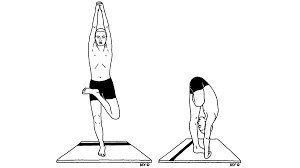In Iyengar Yoga we follow a syllabus. We start with the basic standing poses, move on to the seated poses, abdominal poses, inversions, twists and backbends. The poses are divided into 4 levels of increasing difficulty, with each level building on the previous one. That way, you know what you have to learn before attempting a challenging pose. Or, conversely, if you are stuck, you know how to back up to the part you need to work on in order to move past the obstacle. There is no skipping ahead. The process is orderly and sequential.
Let’s take a look at s progression of poses. In this sequence, I will start with Vrksasana (Tree Pose) and head towards Ardha Baddha Padmottanasana (Half Bound Lotus Standing Forward Bend).
Vrksasana
In order to do Vrksasana you would have had to learn Utthita Trikonasana (Triangle) to open the hips with a straight leg and Virabhadrasana II (Warrior II) to bend the knee.
Utthita Trikonasana
Virabhadrasana II
Vrksasana is a Level I pose. Utthita Ardha Padmottanasana (Upright Half Lotus) is a Level 2 pose and is a harder variation of Vrksasana. Can you see the resemblance? It is in the same family of asanas, lateral standing poses. The upright version is learned before the forward bending stage pictured below.
Utthita Ardha Padmasana on the left and Ardha Padmottanasana on the right
In order to do the pose on the right, can you see that Uttanasana (Standing Forward Bend) is a precursor?
Now, Utthita Ardha Padmasana is not the first time you learn to put a foot in Padmasana. The first time you learn that is in a sated twist called Bharadvajasana II (Bharadvaja is the name of a sage). Obviously, Bharadvajasana I is learned before Bharadvajasana II.
Bharadvajasana I
Bharadvajasana II
We will work on these poses this week in class. We will start with the Swastikasana Chakra and we will work with either Supta Padangusthasana II (Reclined Hand-to-Big-Toe Pose) or Utthita Hasta Padangusthasana II (Standing Hand-to-Big-Toe Pose).
I’ll see you in class!







